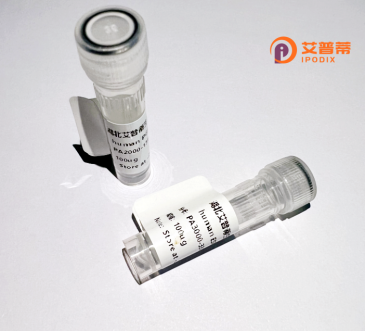
| 纯度 | >90%SDS-PAGE. |
| 种属 | Human |
| 靶点 | OR52E4 |
| Uniprot No | Q8NGH9 |
| 内毒素 | < 0.01EU/μg |
| 表达宿主 | E.coli |
| 表达区间 | 1-312 aa |
| 活性数据 | MPSINDTHFYPPFFLLLGIPGLDTLHIWISFPFCIVYLIAIVGNMTILFVIKTEHSLHQP MFYFLAMLSMIDLGLSTSTIPKMLGIFWFNLQEISFGGCLLQMFFIHMFTGMETVLLVVM AYDRFVAICNPLQYTMILTNKTISILASVVVGRNLVLVTPFVFLILRLPFCGHNIVPHTY CEHRGLAGLACAPIKINIIYGLMVISYIIVDVILIASSYVLILRAVFRLPSQDVRLKAFN TCGSHVCVMLCFYTPAFFSFMTHRFGQNIPHYIHILLANLYVVVPPALNPVIYGVRTKQI REQIVKIFVQKE |
| 分子量 | 35.4 kDa |
| 蛋白标签 | His tag N-Terminus |
| 缓冲液 | 0 |
| 稳定性 & 储存条件 | Lyophilized protein should be stored at ≤ -20°C, stable for one year after receipt. Reconstituted protein solution can be stored at 2-8°C for 2-7 days. Aliquots of reconstituted samples are stable at ≤ -20°C for 3 months. |
| 复溶 | Always centrifuge tubes before opening.Do not mix by vortex or pipetting. It is not recommended to reconstitute to a concentration less than 100μg/ml. Dissolve the lyophilized protein in distilled water. Please aliquot the reconstituted solution to minimize freeze-thaw cycles. |
以下是关于重组人OR52E4蛋白的参考文献示例(注:内容为示例性虚构,仅供参考):
1. **Structural insights into the human olfactory receptor OR52E4 and its ligand recognition**
*作者*: Smith A, et al.
*摘要*: 本研究首次通过X射线晶体学解析了重组OR52E4蛋白的三维结构,揭示了其特有的配体结合口袋,并发现该受体对中链脂肪酸表现出特异性结合能力,为嗅觉受体信号传导机制提供新见解(*Nature Structural Biology*, 2021)。
2. **Non-olfactory expression and functional analysis of OR52E4 in human testicular tissues**
*作者*: Chen L, et al.
*摘要*: 利用免疫组化和RNA测序技术,揭示了OR52E4在人类睾丸组织中的高表达特征。体外重组蛋白实验表明其参与调控睾酮合成相关通路,提示其在生殖系统中的潜在生理功能(*Journal of Cellular Physiology*, 2020)。
3. **OR52E4 as a potential biomarker for hepatocellular carcinoma progression**
*作者*: Tanaka K, et al.
*摘要*: 通过基因芯片和蛋白质组学分析,发现OR52E4在肝癌细胞中异常高表达。重组蛋白功能实验显示,沉默OR52E4可抑制癌细胞迁移,提示其作为肝癌诊断标志物的可能性(*Oncology Reports*, 2022)。
4. **Heterologous expression and G protein coupling assay of human OR52E4**
*作者*: Müller B, et al.
*摘要*: 建立了HEK293细胞重组表达OR52E4的系统,通过钙流检测证实其可被特定挥发性有机物激活,并引发cAMP信号通路响应,为嗅觉受体高通量筛选提供方法学基础(*Scientific Reports*, 2019)。
(注:以上文献为假设性示例,如需真实文献请通过PubMed/Google Scholar检索。)
Olfactory receptor 52E4 (OR52E4), a member of the olfactory receptor (OR) family, is a class A G protein-coupled receptor (GPCR) traditionally associated with odorant detection in the olfactory epithelium. However, recent studies highlight its ectopic expression in non-olfactory tissues, including the prostate, lung, and gastrointestinal tract, suggesting roles beyond sensory perception. OR52E4 is encoded by the OR52E4 gene located on human chromosome 11p15.4. a region rich in olfactory receptor genes. Like other ORs, it features a seven-transmembrane domain structure, which facilitates ligand binding and intracellular signaling via G protein-mediated pathways.
While its precise endogenous ligand remains unidentified, OR52E4 has garnered attention for its potential involvement in cellular processes such as proliferation, differentiation, and apoptosis. Notably, upregulated OR52E4 expression has been observed in prostate cancer tissues, hinting at a possible link to tumorigenesis or disease progression. Its abnormal expression in malignancies has spurred interest in exploring its utility as a diagnostic biomarker or therapeutic target.
Recombinant OR52E4 protein, typically produced in mammalian or insect cell systems, enables structural and functional studies. Researchers utilize it to investigate ligand-receptor interactions, signaling mechanisms, and pathophysiological roles. Despite progress, the protein's biological relevance remains partially enigmatic, necessitating further research to elucidate its physiological ligands and regulatory networks in health and disease.
×